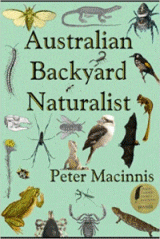
Australian Backyard Naturalist
Australian Backyard Naturalist
Peter Macinnis
Amazon, 2021
212pp., pbk., RRP $A40.00
9798495706415
Anyone who knows Peter Macinnis, either personally or through his writing, knows that he is passionate about connecting young children with science and in this re-creation and complete update of this 2012 award winner he combines his skills in science, history and teaching to bring the reader’s backyard beasties alive and accessible.
In his words, “Here you will meet springtails, pseudoscorpions, onychophorans, leeches, ticks, engaging spiders, mummified lizards. giant worms, some curious plants and even a few rocks. You will learn new ways of catching animals, keeping strange pets that will frighten adults, different ways of looking at them and more. You don’t need a microscope for this, but if you have one, you will have a great deal more fun from this book.”… “The science you find here is stuff that young people can see and do in the class, and then take home and do again and again—and improve on. They can share the methods—and the wonder—with parents, grandparents and neighbours.”
While on the surface this appears to be a book for older readers, it is one for all children who have an interest in what is living and growing literally in their own backyard and Peter has regularly shared photos of his preschool grandchildren exploring their curiosity. While he can probably answer their questions on the spot or suggest activities that will lead them further, this book is a must-have for any adults with curious littlies but not Peter’s expertise and knowledge. They ask a question and the adult can show them how to find the answer in a book!
And if you want to inspire their curiosity, start by marking a square metre of lawn, give them a magnifying glass and challenge them to count all the living things they can see!
Demonstrating that the backyard is more than a stretch of grass to play on, the following chapters are included showing the diversity of life at our fingertips…
- Mammals (bats, possums, and how to use teeth to identify skulls, platypuses {OK, not common in backyards, but interesting}, nesting boxes, making a mammal-friendly backyard);
- Birds (spotting, identifying by appearance, habit, nest and song, attracting birds, problems with feeding, curious bird facts, how to observe birds and their behaviour);
- Amphibians and reptiles (information on attracting, observing, handling and what can be handled, curious facts, a bit about snakes and their venom, the art of catching small skinks, making a frog pond)
- Spiders (observing, keeping, spider relatives and more);
- Butterflies and moths (what to look for);
- Flies and mosquitoes (includes keeping and breeding flies and mosquitoes);
- Ants and ant lions (how to wrangle ant lions and other stuff);
- Other stingers, biters and nasties (wasps, bees, millipedes, centipedes and more);
- Leaf litter animals (all the stuff we never see);
- Snails slugs and their relatives (including the art of keeping them);
- Earthworms and leeches (including a leech barometer);
- Other insects (crickets, grasshoppers, stick insects, mantises and more);
- New chapter: Plants Finding out about plants, looking at prickles, roots and leaves, plant cells and stomates.
- Making your own equipment (there is specific stuff scattered through the book, like how to make and use a butterfly net (in the butterflies chapter), but this chapter has all the general stuff, like a high humidity jar, a Berlese funnel for catching really tiny life forms, a pooter and a fly trap that can also catch yabbies and fish). For this edition, I added hand lenses and assorted microscopes.
As well as being an historian, scientist and teacher, Peter is also a wordsmith and so his writing is entertaining and accessible and the multitude of photographs, diagrams and other illustrations this is a book for anyone who wants to explore and anyone who needs to explain. This is my review of the original which demonstrates in greater detail how Peter not only educates the reader but engages them so they want to know more and discover further.
If this is not in your collection, if you have a child with even a smidge of curiosity and interest, it should be.